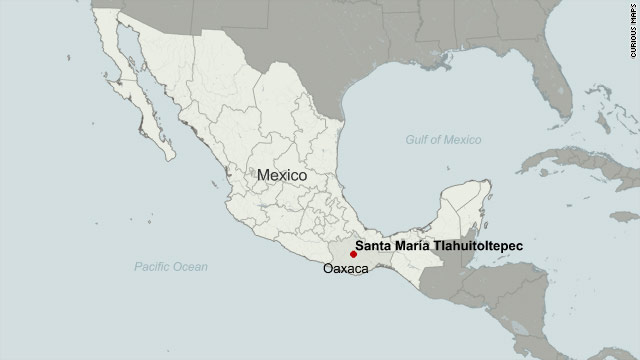
Mexico City, Mexico (CNN) -- Up to 1,000 people may have been trapped by a landslide in the southern Mexico state of Oaxaca, Gov. Ulises Ruiz said Tuesday.
A hill about 650 feet wide (200 meters) collapsed early Tuesday, sending tons of mud over houses in the Santa Maria Tlahuiltotepec municipality, Ruiz said.
"We're talking about some 300 homes affected," Ruiz said. "We don't have the exact number of those affected. But the death toll could reach as many as 500 or 600, even 1,000."
As of Tuesday afternoon, seven bodies had been recovered and 100 people were confirmed missing, civil protection official Luis Marin Castillejos told CNN en Español. The number could increase, he said.
Residents have been evacuated from nearby areas and moved to shelters, but "The danger for the rescuers is imminent," he said.
"We're already rounding up the necessary equipment, and moving it towards the affected area," Ruiz said in an interview on CNN affiliate Televisa.
"We are also moving members of the military, the state police, ambulances, health workers, and all rescue teams available. They're all trying to get there. But, we haven't been able to reach the area, yet. ... We expect to get there in time to rescue these people," he said.
Ruiz said several rivers overflowed their banks due to heavy rain in the area and many roads are blocked by landslides, making it difficult for rescuers to reach the affected areas.
Some residents were complaining Tuesday morning that help was slow in coming.
"Police and rescue officials still have not arrived at the landslide zone and there are many landslides on the road," the Oaxaca Red Cross reported on its Twitter account Tuesday morning.
The region has been plagued by extremely heavy rainfall over the past two weeks, most recently by the remnants of Tropical Storm Matthew, which were still stalled over the area Tuesday, according to CNN Meteorologist Brandon Miller.
Satellite data indicates that nearly 12 inches (300 mm) of rain has fallen in the area of the landslide in the past three days, Miller said.
Many houses are built on the edge of ridges on the steep terrain in the state, which stands about 2,400 feet above sea level, making it conducive to landslides in severe weather.
More rain is forecast in the region in the next day and a half, Miller said.
The severe weather led civil protection authorities to declare a state of emergency Monday for the Oaxaca state municipalities of Oaxaca de Juarez, San Felipe Tejalapam, San Jacinto Amilpas, San Lorenzo Cacaotepec, San Pablo Etla, Santa Lucia del Camino and Tlalixtac de Cabrera. A municipality in Mexico is a geographic division within a state, similar to a county in the United States.
The Santa Maria Tlahuiltotepec municipality is a remote area with about 8,500 residents, located about 182 miles (295 kilometers) from the state capital, Ciudad de Oaxaca.
Residents in Tlahuiltotepec are indigenous -- nearly 99 percent of them speak an indigenous language and about 66 percent also speak Spanish, according to information provided by a local educational institution, the Bachillerato Integral Comunitario Ayuujk Polivalente.
Statistics provided by the institution show a relatively poor area where 43 percent of homes didn't have electricity 10 years ago and 17 percent had no indoor plumbing.
Nearly 40 percent of the municipality's residents were illiterate and only about 10 percent graduated from high school, the institute said.
The statistics came from the year 2000 and show an increasingly higher quality of life compared with 1990.
"Housing construction has evolved considerably," the institute said in a report. "Walls that used to be built with sticks, mud and adobe have been substituted by concrete, which is a mix of sand, lime and cement."
Likewise, the report said, roofing that used to consists of leaves, limbs, and other vegetation has been replaced with aluminum or even concrete tiles.
Most residents are involved in low-level farming, raising livestock and commerce.

No comments:
Post a Comment